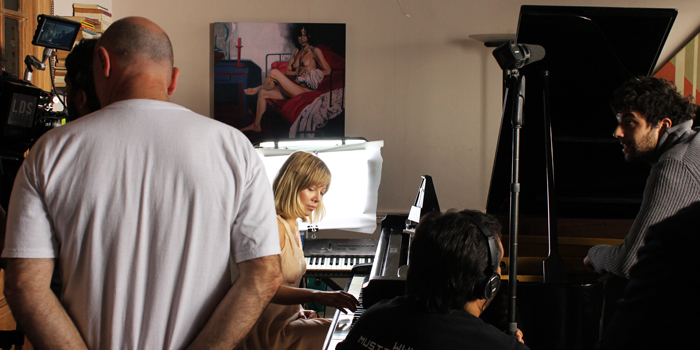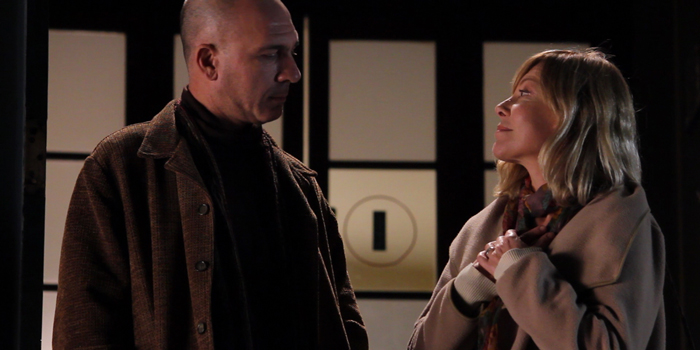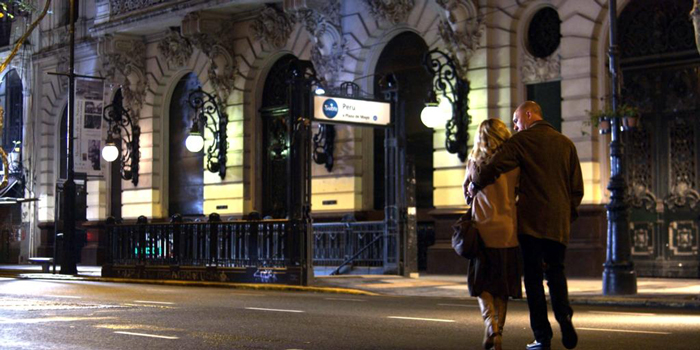
Photo Credit: Quizás porque
Matrimonio (Marriage)│ Tres Pájaros Films│Dir: Carlos Jaureguialzo│Screenplay: Marcela Silva y Nasute│US Release Date: March 3, 2013│Argentina
Today is Bloomsday. If you know what this is, this means you’ve been touched by what is largely considered the best book ever written. The Economist ran a “Why you should read this book” about Ulysses last year. To see this in a “best of” list, feast your eyes here.
This year’s Chicago Latino Film Festival screened a movie version called Matrimonio as the showcase feature of Argentina night. I reviewed it here.
Carlos Jaureguialzo, the director of Matriomonio and husband to the screenwriter (and a producer), Marcela Silva y Nasute, was so kind to answer some of my lingering questions.
Before anything, Jaureguialzo prefaced everything with an important note:
“The screenplay is by Marcela, my wife, so some of the answers may not be accurate, because she is not with me right now.
This fact, that the writer is my wife and we bring over twenty years of marriage is of interest, and the fact that she has Irish ancestry and is very proud of that, too, I suppose, is another point to keep in mind. Here begins and ends the film autobiography. On to your questions.”
My first question had to do with the first moments of the film. In a time when opening credit sequences are rare in most US films, I find myself cherishing them more and more. With Matrimonio, Jaureguialzo orchestrated a supply cleft and hewn string of images and sounds conveying not just the intimate space of a music composer—soft mumblings of phrases, eraser sounds, graphite on paper, piano keys—but the shared space of a composer and her husband. And much like the body of the film itself, there’s a playful quality conveyed throughout. In the novel, Molly Bloom doesn’t make an appearance until the very last chapter, a chapter now referred to as Molly Bloom’s Soliloquy and up until 2001, contained the longest sentence in English literature—this from a chapter composed from just eight sentences. I was hoping Jaureguialzo could talk more about opening the film with the sounds of Molly as composer (in the novel, she’s an opera singer).
Carlos Jaureguialzo: “Indeed, in the beginning we hear the composing (rather than arranging ‘Love’s Old Sweet Song,’ a song which then plays throughout the film.) [Here’s a trailer scored with the version in Matrimonio].
The plan was always to sum up the lives of these two in a single day. Without cheating and relying on just a few elements, we made our presentation. Inanimate objects (save for the cat)—they had history and importance. This was a piecing together of what life is like in the predawn hours with the vestiges of the previous day’s work of Molly’s lie strewn. This is the most I can say. It doesn’t have much more sense… And also to feel the presence of her from the beginning.”
My second question had to do with the changes of occupation in the main characters husband and wife. In the novel, Molly is an opera singer and her husband works in advertising. In the film, wife is a composer and Esteban is a perfumer, although he still plays a hand in the advertising of such. I wondered about the significance of these changes.
Carlos Jaureguialzo: “This would be the view of Marcela. She is unable to answer. Maybe we can get you to answer. Having said that, perhaps being a composer is better suited for the visual as well as musical. It isn’t about control. My interpretation of the perfume I extend to you.”
Arguably, there is risk involved whenever an artist shares a detailed analysis of their work. It wasn’t a shocker, then, that Jaureguialzo was a bit coy in answering my question. And by “coy” I mean a “non-answer answer”…but cuter. My question (which I clumsily labeled as “hermeneutics”): “Just as there are many ways of reading Ulysses, are there many ways of watching Matrimonio? And I know you could dismiss the question because anything can be taken in any way, but as a director, you created something that begins in the vacuum of your mind.”
Carlos Jaureguialzo: “I suppose there can be many ways to read Matrimonio. And I guess some of my answers will surprise or disappoint.”
You can see perfectly in your mind’s eye the grin and sparkle in the eye. Cute. But coy.
Novels do not always make for successful films. The Human Stain comes to mind as a train wreck of an adaptation. Love in the Time of Cholera was also such a calamity (although the score was beautiful). In addressing these perils, Jaureguialzo had more to say.
Carlos Jaureguialzo: “With some criticism of Buenos Aires, more defeats than victories. Indeed the novel was an outstanding guide to make the film, but as you say, is inspired by the book, it is not an adaptation therefore abandoned for many times the concrete meaning of the novel. Occurs, saving the great distances, which occurs between ‘Ulysses’ and ‘The Odyssey’ by Homer, who always tries to get one in the mold of the other, and for me, Joyce, just stole the structure . That is, after all the journey of this man for Dublin, he met his wife missing to complete your profile. Then, work on: ‘Meanwhile in Ithaca …’ and give input to Penelope and their resistance to the attacks of her suitors. With our film goes a bit the same. We served this structure of Ulysses to tell our story, but we want to put to match.’
There’s a moment early on in the film when the husband – Esteban – discovers his wife’s diary. At the time, I thought this would be a crucial moment in the plot. Instead, the swell of excitement at this find quickly diminished, a brilliant move suggesting that the situation was much more complicated, beyond such things as found diaries. I wanted Jaureguialzo to say more about this.
Carlos Jaureguialzo: “Molly’s planner or ‘diary’ is chance for Esteban to pry into her world. It’s an idea that seduces him and yet he is ashamed. At the bar, he ends up writing and on the bar napkins, perpetrating the violation of their privacy. Not much else to say.”
One of the more seminal achievements of Ulysses involves its interior monologues. This is cleverly played out in the film. My question: “The interior lives of Leopold and Molly seem at odds with film because film is such a visual medium. It seemed you celebrated this and even mocked it in scenes like when Leopold visits his therapist and spends virtually the entire time in interior monologue—and comfortably so!—to Molly’s perfume and song scene to many more. What was strange is that I didn’t get the sense that all this internal chatter was strange. Can you talk about the challenge of including so much interior monologue in your film as well as how this freed you up to use the visual as a foil or way to improvise against the monologue?”
Carlos Jaureguialzo: “‘Ulysses’ develops interior monologue as a basic form of narrative. In movies the characters are expressed through action, and there has been virtually no other way to express their thoughts on film if it was not through voiceover. We wanted to explore a little that way but give some twist to the voiceover. We believe that Joyce had a mocking spirit, that he was so irreverent. Puns, images such as drinking beer before they take the rats, etc. We also tried not to be solemn and overcomplicate with puzzling, complicated plot. Many meanings of the film go against what you can do in cinema (eg. the interior life of the characters). Esteban discovers that Molly still loves through the perfume, something which smells not while at the movies.
Music. From score to soundtrack to effects, what you hear in a film is of great importance, a character unto itself. In Lincoln, Spielberg cared so much for authenticity, he recorded the actual tick-tock of Lincoln’s pocket watch for the film. And actually – sorry for the tangent – the Kentucky Historical Society is under fire for winding the damn thing for the recording. The Turkish lullaby in The English Patient still makes me quake. And Hans Zimmer, in a Reddit Q&A showing, admitted to incredible procrastination and angst as he tried to best one of the most recognizable themes in cinema, that of John Williams Superman theme. I’m excited to hear his take.
In Matrimonio, Jaureguialzo filled the screen with thoughtful jazz-infused scoring. Think contemporary Bill Conti meets Dave Grusin. A cover of “The Man I Love” proved to be an almost holy moment in the character of Molly, and—as mentioned previously—“Love’s Old Sweet Song” finds itself enmeshed in the film as much as in the novel. And so, when Esteban actually sings in the film, I anticipated that it would have been glorious. Instead, it seemed to be the least musical part of the entire film.
Carlos Jaureguialzo: “It’s a small defeat for Esteban that he’s unable to penetrate the innermost world of Molly.”
Sometimes it’s as simple as that. A man can’t understand his wife, gets wasted at a bar, sings a little and moves on.
The story behind the two covered songs, however, is more complex.
Carlos Jaureguialzo: “There are coincidences provided by film. When we were exhausted and without anything to use, it turns out our daughter Delfina, who did the editing, made us listen to Ludmila. We were convinced immediately to go with her. And then she convinced us to give Santiago, a companion from her school days, the sheet music for ‘Love’s Old Sweet Song.’ He arranged something with his guitar. In my opinion, these were two wise moves. We only had to decide where we wanted the songs.”
From music to interior dialogue to…sex? Yes. While Matrimonio hasn’t made any banned lists yet, Ulysses was banned from the US when it was first published in 1922. By today’s standards, as you might imagine, nothing was lurid. In the film, the question of infidelity never finds a concrete fixture in our minds as well as in the minds of Molly and Esteban. Rather, you begin to suspect that the definition of infidelity looms larger than the proverbial bedroom and knickers.
Carlos Jaureguialzo: “Molly and Esteban love. Infidelity, in this case, isn’t a very comfortable option. The fate of the characters are not settled in any place within the novel. In any case, the confusing vision of her husband on the subway pushes her to keep her appointment, thus generating new adventures. [This is in reference to me asking about the consequence of Molly seeing what looks like another woman in the arms of Esteban]”
Like life, Matrimonio contained numerous scenes where the characters visit that same locations but just at different times. What are we, the viewers, supposed to make of this? Coincidence? What does it all mean? Apparently, not much.
Carlos Jaureguialzo: “I could not answer you. They are two similar people with similar tastes. That the viewer must see. It’s a reality of storytelling that in the telling, a third point of view—that of the spectator—is created. It’s like the concept of Eisenstein on montage: two planes juxtaposed generate a third concept is not entirely contained in any of the previous drawings. A woman crying. A coffin. Concept emerging: a widow. Similarly, we, the viewer, see them react to the same stimuli, drawing our own conclusions that are not expressly contained in the action.”
Answers seemed to remain within the realm of the film theory Eisenstein would have been comfortable with. When asked to speak to several other scenes that seemed the leave the characters nonplussed – for instance, when Molly is taken captive on the elevator – I got this answer.
Carlos Jaureguialzo: Well, the dramatic tone in these few scenes is not casual, belonging to itself and not so much for the rest of the film
On the happy ending with Molly not only smelling the perfume but Esteban smelling it on her (tantamount to him finally finding nonnegotiable peace and security as it pertains to his trust and love in her), there seems to be no real catharsis reflecting all the cerebral, neurosis so prevalent for much of the film, there seems to be, albeit a happy one, a conceit.
Carlos Jaureguialzo: “It’s not that we were looking to send a message, but one must resolve the fate of his characters and these two deserved end up together, if only for another day.”
Before the end credits roll, a quote from Simone de Beauvoir appears:
“His death separates us. My death will not reunite us. It is splendid that we were able to live our lives in harmony for so long”
Carlos Jaureguialzo: “The phrase makes sense for us. In the worst of times, we have suffered the loss of many loved ones, abruptly and prematurely from diseases. Beauvoir’s phrase alludes to death, as many passages of the film. I think she should be atheistic or agnostic like us, and if it ends with death, all that remains of the relationships is that you build it throughout life, lovingly. It is very sad and has no remedy.”
Lastly, on Bloomsday…
Carlos Jaureguialzo: “I’ve never partaken in Bloomsday. We are fans. I read Ulysses as a teenager and reread it a few years ago. I went over it a bit in preparation for the film. I have no tattoo, though.
And on plans for the next film…
Our next film we are about to start is called “The Irish Prisoner” (I told you Marcela has descent …). It’s about an Irish soldier enlisted in the British army taken prisoner in the British Invasions (1806), ends up in Argentina and ends participating in the war for our independence from Spain.”























